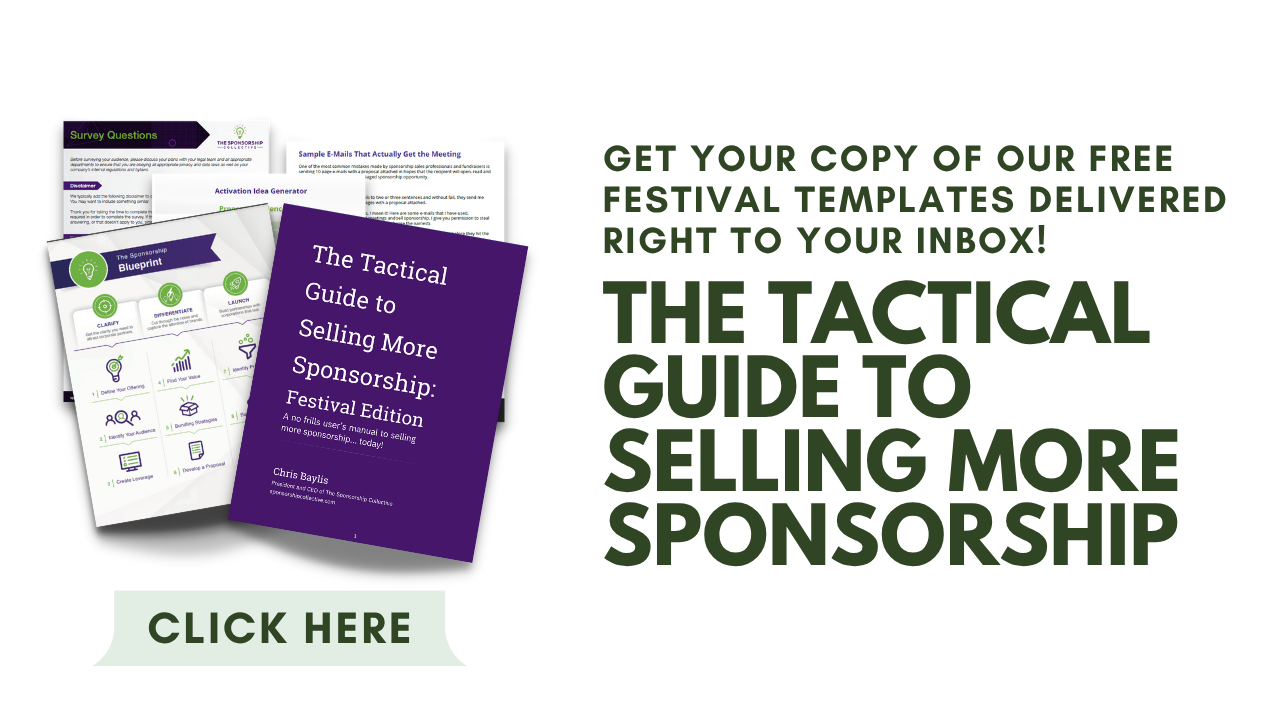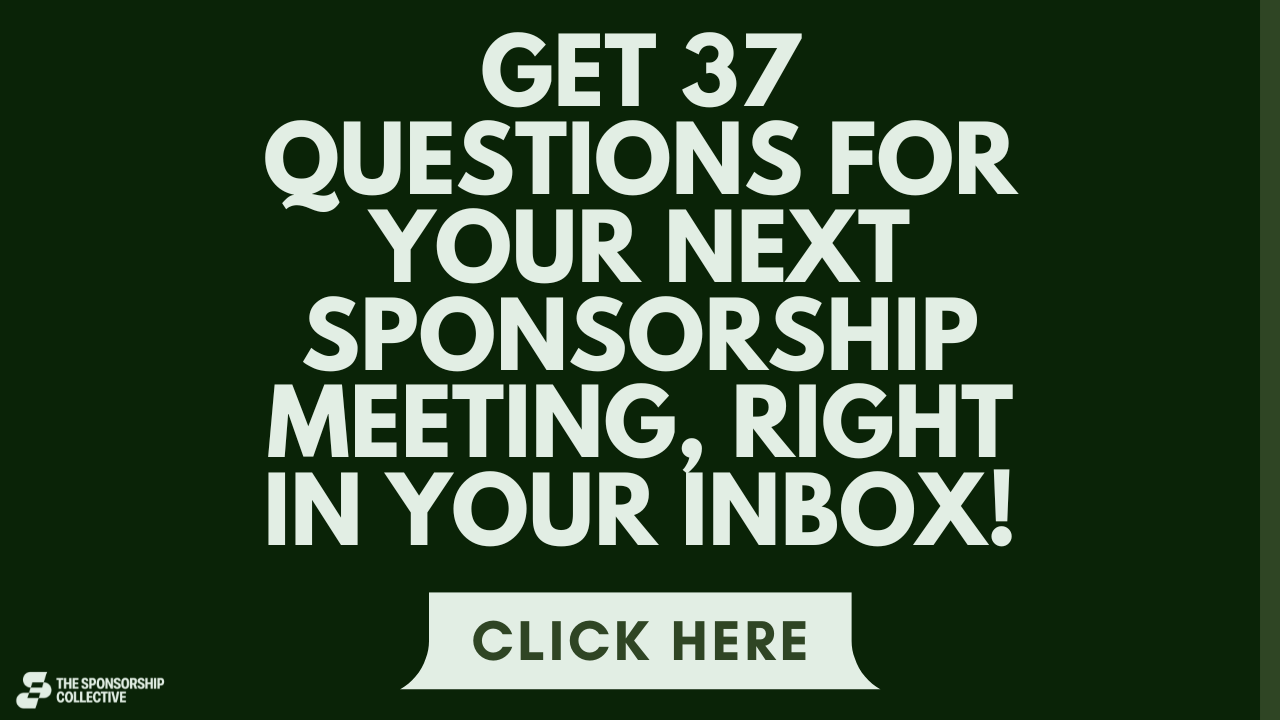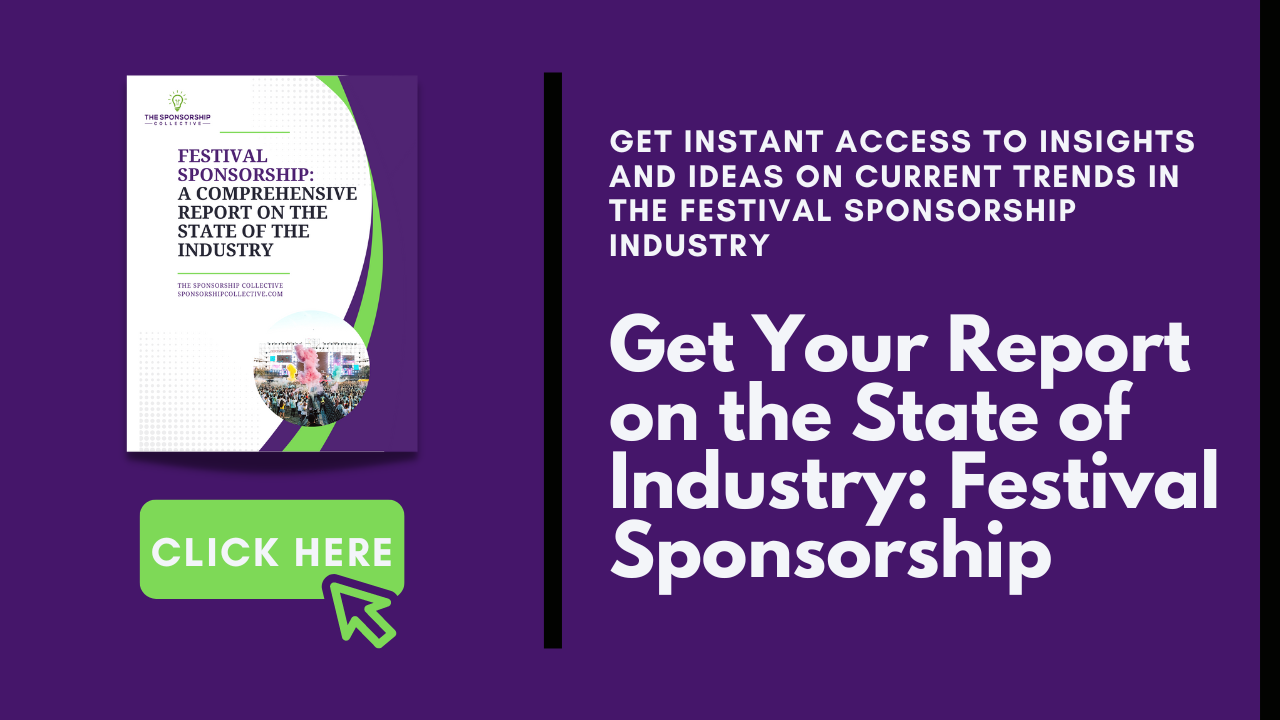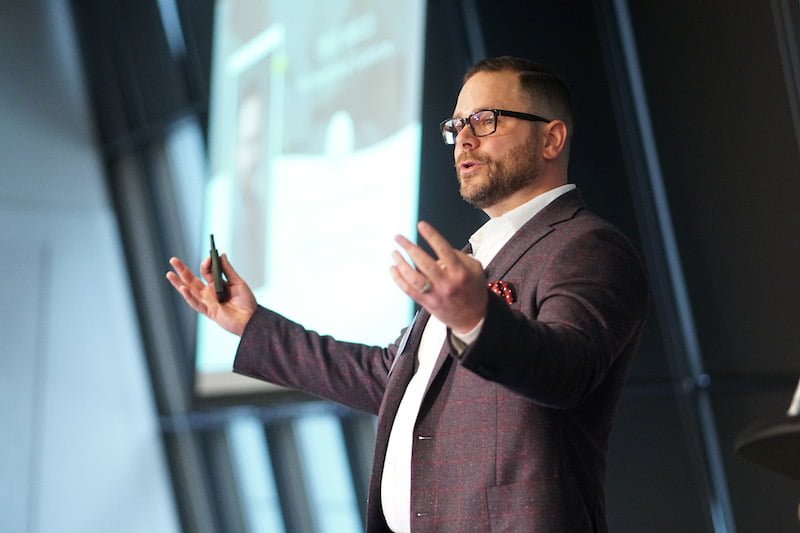Festivals usually attract a bevy of sponsors, including promotional and cash sponsors. With so many partners on your plate, it’s integral you measure the success of each sponsor to gauge whether you’ll work with them again. What kinds of data do you need to measure festival sponsor success?
Here’s how to measure the success of festival sponsors:
- Tickets sold
- Attendance
- Net promotor score
- Customer feedback
- Social media interactions
- Website visits
- Email open rates
- Email click-through rates
- Onsite purchases
- New leads
- Lead quality
- Brand impressions
Most of the content I write on the blog is directed at sponsorship seekers looking to gain the attention of a sponsor. Just because you have that attention doesn’t always mean you have to keep it. This guide will go over the above 12 metrics in more detail so you can see how your festival sponsors stack up!
The Importance of Measuring the Success of Your Festival Sponsorships
Running a festival takes all the energy, manpower, and time you have. Then, when it’s finally over, you have to turn around and do it all over again in preparation for next year.
I’m sure the last thing you want to do is spend too long mulling over how well the past festival went when you need to begin preparations for the next one, but you must. Here are three very compelling reasons why that is.
For the Fulfillment Report
When you work with a sponsor, your final obligation to them isn’t ending the event. Instead, it’s the post-event or wrap-up report, also known as the fulfillment report.

The fulfillment report is when you go back and rehash all the small details of your festival just gone by. It’s as much for your festival sponsors as it is for you, as you can see where you fell short and begin planning how to do better next year.
To Determine If You Should Renegotiate with the Sponsor
The wrap-up report is very telling, as you can see how the festival transpired as a whole and whether it benefitted from your sponsor’s involvement. It might be that certain sponsors drove more results than others.
There’s no rule that says you must tether yourself to the same sponsors year after year. If you feel like your festival isn’t excelling due to a sponsor’s involvement, you don’t even have to formally cut the cord.
After delivering the post-event report, you can merely thank them for their time, and that’s it. Don’t block them or anything dramatic. Burning bridges is foolish when you might need the sponsor down the line.
Perhaps they can recommend you another great sponsor, or they know someone you need to know. Keep things cordial for that very reason.
For Future Case Studies
In a recent post on the blog, I talked about what makes sponsorship seekers positively magnetic to sponsors. One of the elements is case studies.
A case study is the best form of self-promotion. In the case study, you get to talk about yourself and how you helped another sponsor, client, or partner.
When writing a case study, you must include rich data. The details of your festival become fuzzier the further removed you are from it, so it’s best to have event data to look back on. Your case studies will come out great!
12 Methods for Measuring Festival Sponsorship Success
For the rest of this guide, I’ll review each of the metrics from the intro you can use to decide whether your festival sponsorship is worth retaining.
1. Tickets Sold
Let’s start with an easy KPI, how many tickets your festival sold.
Now, on its own, the number of tickets sold doesn’t tell you anything except well, how many tickets you sold for this year’s festival.
You’re looking for more than that, like ROI. That means you must compare this year’s tickets sold against past data.
If your festival is in its first year, you won’t be able to do this yet. Even if your festival is only in its second year, you can still look at this year’s data versus last year’s.
Did the number of tickets sold this year eclipse last year’s? That’s the idea, but even a moderate increase is still on the right track. That said, you will need several more years’ worth of data to see if the uptick sticks.
Now, I should note that an increase in the number of tickets you sell does not alone come down to your sponsors. If you also increased your social media and marketing campaigns, you have to give credit where it’s due.
However, your sponsors overall contributed to a positive element of your festival, and that’s what you’re paying attention to here.
2. Festival Attendance
Here’s the thing about ticket sales: they’re not the most accurate gauge of the success of your festival.
You see, anyone can buy tickets to your festival, but how many of them showed up when it counts? To answer that question, you must measure festival attendance.
It’s easier than ever these days to keep track of who entered your building or festival grounds, whether you use RFID badges or scannable digital or printed tickets.
Once you have your attendance data, you can compare it in several ways. First, look at last year’s attendance numbers and then the year prior if you can. Has attendance steadily risen?
You should also look at the number of tickets you sold for this year’s festival against the attendance. The two numbers shouldn’t drastically differ. If they did, you and your team must try to figure out why.
If you just brought on sponsors for the first time this year, you can easily see the stark contrast between a no-sponsor festival versus one with sponsors.
If your sponsors brought in more ticket sales and–even more critically–more attendance, you should strongly consider renegotiating with them, especially if you enjoyed working with them.
3. Net Promotor Score
I discussed the net promotor score or NPS in another recent post, so this will be more like a recap.
NPS is a measure of customer loyalty. After your latest festival, ask your audience whether they’d recommend your festival to others on a scale of 0 to 10.

Those who answer 0 through 6 are detractors. They don’t like your event and probably won’t go again unless you strive to understand their low score and improve your festival further based on their feedback.
The audience members who answered with a 7 or 8 are passives. These parties don’t really care much either way about your festival. Ambivalence is better than active distaste but still not great, so you should focus on this group and how to make your festival better.
Festival attendees who rated your event a 9 or 10 are loyal customers. You want as many of these customers as possible, as they’ll always attend your festival and even bring on new people over time.
Maybe they recommend your festival to friends and family, or perhaps they bring their kids to your festival (if they have them).
How do you use the net promotor score as a measure of festival sponsorship success? Just as you have the entire time, by comparing this year’s scores against past years. Then, deduce how much involvement your sponsor had in improving audience morale.
4. Customer Feedback
While the NPS is a great gauge of how your audience feels about your festival, it doesn’t tell the whole story because you only asked one question.
You can expand on the questions you ask by issuing a short post-event survey. Here are some questions you can include:
- Is this your first year attending the festival? If not, how many years have you gone?
- What made you want to go to the festival?
- How do you hear about the festival?
- What exhibits did you see/attend at the festival?
- What was your favorite part of the festival?
- What was your least favorite part of the festival?
- What would you change or improve for next year?
Just like when you issue an audience survey, you must incentivize your customers to complete a feedback survey. You might offer entry into a raffle or giveaway, access to exclusive festival news, or even a discount on a festival package for next year.
The feedback you receive will be more telling than the NPS. Keep an eye out for repeated responses, as these are topics that a lot of your attendees agree on. If you’re eager to take feedback to make your festival attendees even happier next year, start with these areas.
5. Social Media Interactions
The next KPI you can study to gauge the success of festival sponsorship is social media interactions and engagement.
Before your festival, you promoted the event and the sponsors associated with it. Did the sponsor’s involvement lead to more social media outcomes for your festival?
For instance, did you get more retweets or reposts, comments, shares, likes, and follows?
If so, how much more social media engagement did you get before working with the sponsor and after? If yours is a promotional sponsor, the answer should be a lot more!
Social media interactions and engagement are especially important if you’re trying to push more brand awareness or your festival recently rebranded and you’re trying to promote it all over again.
However, this isn’t the most important metric as a whole unless your social media engagement leads to more ticket sales and attendance.
6. Website Visits
Just as your social media pages were abuzz ahead of, during, and immediately after your festival, you should have noticed an increase in website visitors.
Even if your festival is in its first year, you can still use website visits as a valuable metric in gauging the efficiency of a festival sponsor. Simply review your website traffic before working with the sponsor versus after.
Both social media and your website can increase your lead generation, but not if you’re passive about it. When attendees or curious potential attendees land on your social media pages, you want to guide them to your website.
Your festival website should have opt-in forms to capture lead contact information. Your lead will join your newsletter, where they can continue to receive updates about your festival until the show date. Then they’d get news on the next year’s festival.
7. Email Open Rate
The next metric to manage is email open rates. As your festival gears up for another year, the rate of emails you send will ramp up. That email cadence will continue until after the festival when naturally, your email send rate will begin to decrease.
You won’t become a total ghost, but you might send emails every couple of weeks or every month rather than every other day like you were.
However, no matter how frequently you send emails associated with your festival, it won’t matter if no one opens them.
Sponsors–especially promotional sponsors–should get your audience excited about your festival. You should see an increase in your email open rate due to the sponsors associated with your event.
When comparing email open rates from year to year, make sure you’re looking at the same period. For instance, if you compare this year’s email open rate a week before your festival versus last year’s email open rate six months out from your festival, of course, last year’s data will be lower.
That can make your open rate look a lot more impressive than it truly is!
8. Email Click-Through Rate
Accompanying the email open rate, you must also measure the email click-through rate. This KPI is all about whether the people who opened your emails clicked the links.
I’m sure you’ve opened an email accidentally in an overflowing inbox. Perhaps you meant to open the email so you can unsubscribe or report the message as spam to stop future correspondence.
That’s why the email open rate isn’t enough to track. That’d be like only looking at your tickets sold rather than the attendance.
If no one engages with the content of your emails, the open rate can feel artificial and hollow. The two rates should be similar, but it’s okay if one is slightly higher than the other.
9. Onsite Purchases
You can rake in more money during your festival than through ticket sales alone, but also merch, food and drink, and other onsite purchases.
To figure out if having a sponsor or sponsors for your festival got your attendees in a spending mood, review this year’s onsite purchases and last year’s. You can even dig back several years if you wish.
You’re hoping to see an upward trajectory, but keep in mind that vendors and marketing efforts can also drive more onsite purchases. You’ll need to honestly assess what your sponsor’s role was in the increase.
10. New Leads
Every company wants more leads, including your festival. Leads will continually discover your festival and keep growing your audience.
How many leads do you get before and during your festival? Is the number of leads higher than your normal lead flow? What about compared to your festival last year? Did you pull in more leads this time around?
Once more, you must ask how much involvement your sponsor had in accruing more leads for your festival. For example, if they’re a promotional sponsor, they probably were quite heavy-handed in increasing lead gen.
11. Lead Quality
Not all leads are created equally. Qualified leads are readier to make a purchasing decision, i.e., buy festival tickets. They’re deeper into the sales funnel than unqualified leads. Those leads enter the sales funnel at the very beginning and can drop off at any point.

Measuring lead quality can also indicate how much money a lead will spend on your festival, which informs revenue projections.
12. Brand Impressions
The last way to measure the success of your festival sponsorship is to review brand impressions. You’re tracking for any mentions of your brand across press releases, local press, international press (hey, if your sponsor is big enough, anything is possible), podcasts, radio, television, digital outlets, and print media.
Conclusion
Measuring the success of your festival sponsorships starts with these 12 metrics. From there, you can determine whether pairing up with the same sponsor again next year is in the best interest of your festival.
If you want to further the professional relationship with your sponsor through renegotiation, don’t miss this post!
- About the Author
- Latest Posts
Chris Baylis is the Founder and Editor-in-Chief of The Sponsorship Collective.
After spending several years in the field as a sponsorship professional and consultant, Chris now spends his time working with clients to help them understand their audiences, build activations that sponsors want, apply market values to their assets and build strategies that drive sales.
Read More about Chris Baylis

